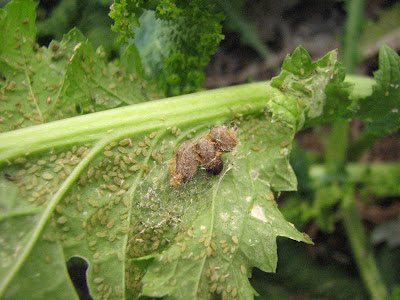As a kid I was fascinated with bugs (to say the least) and I have probably, from egg to egg, raised ladybugs, Anise Swallowtail butterflies, Painted Lady Butterflies, and Praying Mantises with the last being the most difficult. Most insect pests have predators - so it can greatly help to know each kind of beneficial insect (those that eat your insect pests) that lives in your area and how you can use them to minimize your crop damage and work. I would much rather have beneficial insects do the work of eliminating pests for me.
 |
| Grey Aphids can do some damage to the top of plants |
 |
| Aphidius colemani parasitic wasps finding aphids on the leaf |
There are some insect pests whose presence in my garden must be addressed immediately, because of the extent of damage a few can cause and because they have no native predators to bring their population down to numbers that are acceptable to me. These include cucumber beetles, tomato hornworms, squash vine borers, and cutworms. Many of the rest of my pests I rely on beneficial insects to take care of. The most common pest in my garden is aphids. With wings that enable them to fly from one location to another, with ants working hard to protect them (ants harvest nectar from many kinds of aphids), and with the ability to double their population in a matter of days aphids can do a lot of damage to a garden. Their method of attack is sucking juice from the plant, which weakens the plant and can result in leaf curl of both old and new growth. Aphids have many enemies including parasitic wasps, the fuzzy Scymnus beetle larvae, lacewing nymphs, ladybug nymphs and various caterpillars and nymphs of other kinds.
 |
| Aphidius colemani parasitic wasp hatching from prey. |
 |
| Hoverfly Larvae eat aphids. |
 |
| Scymnus beetle larvae enjoy eating aphids too |
| Lacewing Egg on a leaf. |
 |
| Adult Green Lacewing |
My all time favorite of these is the Aphidius colemani parasitic wasp followed by the lacewing. The female A. colemani wasp flies from leaf to leaf, poking her egg laying tube into various aphids to lay eggs in them as she desires. The aphids eventually turn yellow then golden as the new wasp grows within the aphid, then eats it from the inside out. Then the wasp cuts an opening out of the aphid shell and starts the process all over again. Why I love the A. colemani wasp so much is that it can really take the Tucson heat and the ants and aphids just cannot compete with it. I really enjoy lacewings as well. They stay in Tucson throughout the year and are a real help whenever I need a bug to take care of my aphids.
The other beneficial insects I have noted appear in small numbers throughout the year, depending upon how much heat or cold they can tolerate. They complement the A colemani and lacewings but seem to only come in as backup when aphid populations get really high.
 |
| Fast ladybugs are difficult to catch on camera |
| Cabbage Looper caterpillar... |
| ...plus caterpillar Parasitic Wasp... |
| ...equals new home for wasps! |
The only other beneficial insect of note for the garden is the praying mantis, which does well in established gardens. Mantises tend to thrive in long-standing gardens with multiple stories of foliage. This is because they feed on different insects throughout their life cycle. Though they can live in many environments, they prefer eating flying insects and residing on flowering plants that attract insects half the length of their arm. Got all that? Mantises can be difficult to keep in an area, unless you have enough area to support their prey and to keep them safe from larger predators. Many kinds of mantises inhabit Arizona (including Tucson), but the most common variety I find in Tucson is the Mediterranean Mantis, or Iris oratoria.
So how do I attract beneficial insects? The first way I do this is to give them a healthy food source – which means I let the pests thrive. I usually try to start a population of pests and predators early in the spring so that I can enjoy the benefits of beneficial insects all summer and fall. And what if no beneficial insects thrive in my area? I could purchase some varieties from companies that could do well in my climate or I could kill bugs by hand. As for me, I prefer the method with the least work – let the beneficials do the work.



















